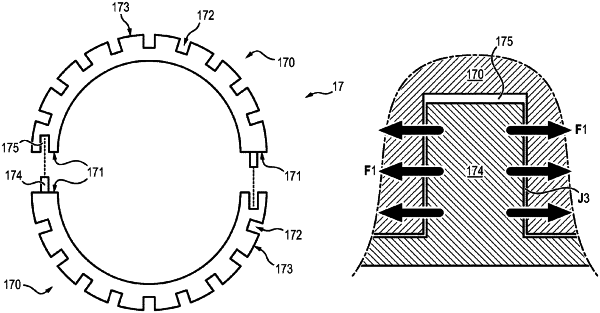| CPC F01D 17/162 (2013.01) [F01D 25/24 (2013.01); F04D 19/02 (2013.01); F04D 29/52 (2013.01); F04D 29/54 (2013.01); F04D 29/56 (2013.01); F04D 29/563 (2013.01); F04D 29/64 (2013.01); F05D 2220/323 (2013.01); F05D 2240/128 (2013.01); F05D 2260/60 (2013.01)] | 11 Claims |

|
1. An inner ring comprising at least two ring sectors, assembled circumferentially end to end so as to form the inner ring, each of the at least two ring sectors comprising a plurality of housings for receiving a radially inner pivot axis of one of a plurality of variable-pitch blades,
wherein each of the at least two ring sectors has two ends,
wherein there is a junction plane between the two ends of the at least two ring sectors that form an assembly,
wherein at each junction plane between the two ends of the at least two ring sectors that that from the assembly of two successive ring sectors, the assembly of the two successive ring sectors is performed by cooperation of an assembly pin and a cavity for receiving the assembly pin, the assembly pin being fixed on one of the two ends of one of the two successive ring sectors and the cavity being formed at one of the two ends of the other of the two successive ring sectors,
wherein the cavity is configured and dimensioned to receive the assembly pin with a mounting clearance allowing a mounting by sliding fit,
and wherein the assembly pin is made of a material having a coefficient of thermal expansion greater than a coefficient of thermal expansion of a material constituting the two successive ring sectors so that during a temperature rise, the assembly pin expands more inside the cavity than the cavity itself, thus ensuring the inseparable assembly of the two successive ring sectors and so that during a temperature decrease, the assembly pin retracts inside the cavity, by allowing a dismounting of the two successive ring sectors.
|